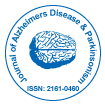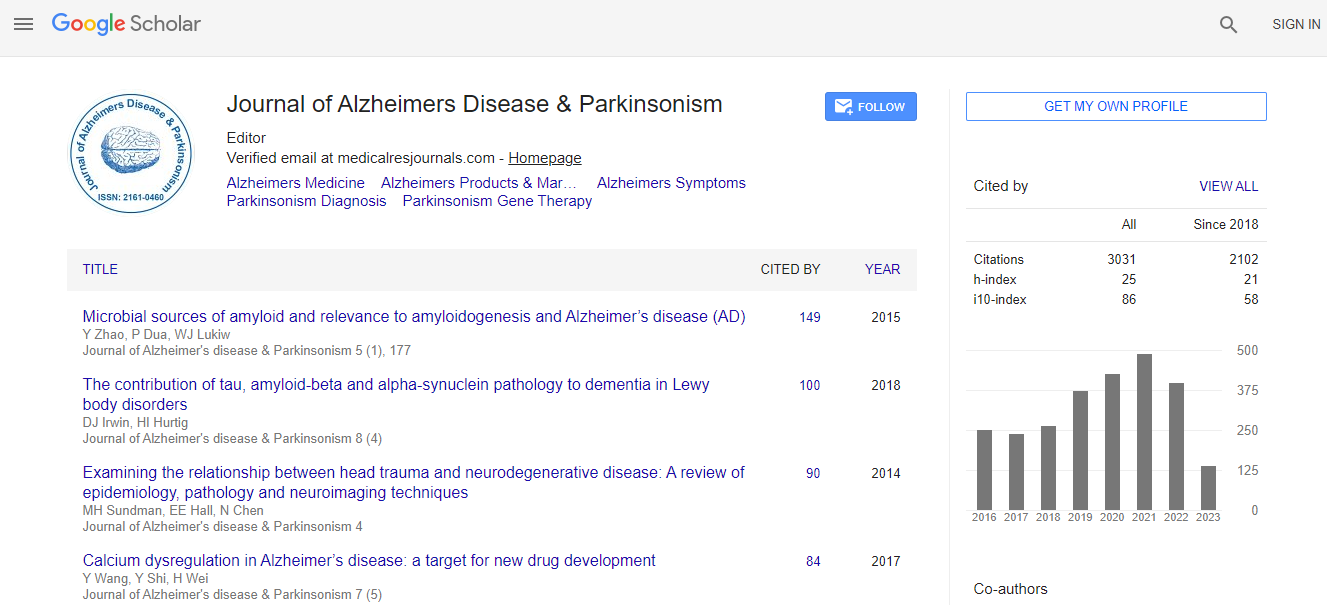Our Group organises 3000+ Global Conferenceseries Events every year across USA, Europe & Asia with support from 1000 more scientific Societies and Publishes 700+ Open Access Journals which contains over 50000 eminent personalities, reputed scientists as editorial board members.
Open Access Journals gaining more Readers and Citations
700 Journals and 15,000,000 Readers Each Journal is getting 25,000+ Readers
Google Scholar citation report
Citations : 4334
Journal of Alzheimers Disease & Parkinsonism received 4334 citations as per Google Scholar report
Journal of Alzheimers Disease & Parkinsonism peer review process verified at publons
Indexed In
- Index Copernicus
- Google Scholar
- Sherpa Romeo
- Open J Gate
- Genamics JournalSeek
- Academic Keys
- JournalTOCs
- China National Knowledge Infrastructure (CNKI)
- Electronic Journals Library
- RefSeek
- Hamdard University
- EBSCO A-Z
- OCLC- WorldCat
- SWB online catalog
- Virtual Library of Biology (vifabio)
- Publons
- Geneva Foundation for Medical Education and Research
- Euro Pub
- ICMJE
Useful Links
Recommended Journals
Related Subjects
Share This Page
Potential therapeutic implications of gelsolin in Alzheimers disease
13th Annual Conference on Dementia and Alzheimers Disease
Ved Chauhan and Abha Chauhan
New York State Institute for Basic Research in Developmental Disabilities, USA
ScientificTracks Abstracts: J Alzheimers Dis Parkinsonism
Abstract
Deposition of fibrils Amyloid Beta-protein (Aβ) as amyloid plaques in the brain is a prominent feature in the pathology of AD. Gelsolin a multifunctional actin-binding protein is present as circulatory protein in plasma (p-gelsolin) and its shorter form is present in the cytoplasm (c-gelsolin). We have reported that gelsolin forms a complex with Aβ and gelsolin inhibits A fibrillization and it also solubilizes preformed Aβ fibrils. These findings suggest anti-amyloidogenic property of gelsolin. Other studies have also shown reduced amyloid load with peripheral administration of p-gelsolin or transgene expression of c-gelsolin in the transgenic mouse model of AD. The levels of gelsolin can also be increased epigenetically by inhibition of histone deacetylases, such as Trichostatin A (TSA). TSA has been reported to increase gelsolin expression in cell cultures and brain. We studied whether TSA can act as a potential therapeutic agent in AD through clearance of Aβ by affecting the levels of plasma/brain gelsolin in APPswe/PS1δE9 transgenic mouse model of AD. Intraperitoneal administration of TSA to these AD-tg mice for two months improved the learning ability during the Morris water maze training process. The western blots showed increased plasma levels of gelsolin, Aβ 1-40/Aβ 1-42 in TSA-treated mice as compared with vehicle-treated control mice. A positive correlation was observed between the plasma levels of gelsolin and Aβ 1-40 / Aβ 1-42 in AD-tg mice. These results suggest that TSA may help in Aβ clearance by inducing the expression of gelsolin, thus improving the learning skills. It seems that plasma gelsolin probably acts as peripheral sink protein to bind Aβ peptides and therefore help in Aβ clearance.Biography
Ved Chauhan is the head of the Cellular Neurochemistry Laboratory at New York State Institute for Basic Research in Developmental Disabilities, New York. He has received his PhD from Post Graduate Institute of Medical Education and Research, India. After working as a Research Associate for two years at the University of Southern California, he joined IBR as a Research Scientist. He has published over 100 research articles in the field of signal transduction, membrane biochemistry, Alzheimer’s disease and autism. For his work on Alzheimer’s disease and Autism, he has been awarded several research grants as Principal Investigator from NIH, Alzheimer’s Association and Autism Research Institute. He has also served as an Editorial Board Member of many journals.
E-mail: ved.chauhan@opwdd.ny.gov

 Spanish
Spanish  Chinese
Chinese  Russian
Russian  German
German  French
French  Japanese
Japanese  Portuguese
Portuguese  Hindi
Hindi 
